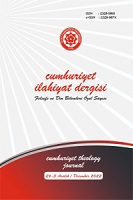Din-Bilim İlişkisi Tutum Ölçeği
Religion-Science Relationship Attitude Scale
Author(s): Ahmet Çakmak, Fikrullah Çakmak, Hüsnü AydenizSubject(s): Islam studies, Religion and science , Philosophy of Religion, Sociology of Education
Published by: Cumhuriyet Üniversitesi İlahyat Fakültesi
Keywords: Religious Education; Philosophy of Religion; Kalām; Religion-Science Relationship; Scale Development;
Summary/Abstract: The purpose of this study is to develop a religion-science relationship attitude scale prepared to determine the approaches of the students studying at the faculties of theology/Islamic sciences towards the religion-science relationship. The relationship between religion and science constitutes one of the most important intersection points of religion, science and philosophy. In the modern period, the debates on the questioning of this relationship have reached quite advanced dimensions with the influence of different elements. In recent years, one of the environments in which this situation has intensified in our country is theology/Islamic sciences faculties. Especially for the students of these faculties, it is important to deal with the issue from different dimensions. However, the studies are mainly carried out in the theoretical dimension and it can be said that the quantitative dimensions are inadequate. In this respect, the article is the first example in the field. Ian G. Barbour's quartet typology, which is one of the most comprehensive studies on the religion-science relationship was used as a basis in the formation of the scale questions. Especially conflict, separation and reconciliation approaches in this typology have been decisive. Three different study groups were formed and a total of 594 students studying at Atatürk University Faculty of Theology were studied. In the development of the scale, exploratory sequential pattern model from mixed method research was used and there are four steps. In the first step, the items were written by the researchers and corrections were made by taking the opinions of the field experts. In the second step, an application was made for item analysis; in the third step, an application was made for exploratory factor analysis (EFA), and in the fourth and final step, confirmatory factor analysis (CFA) was performed. According to the findings obtained from the study, a scale consisting of two sub-dimensions called conflict/separation and dialogue/consensus was developed. The reliability of the scale was analyzed with the internal consistency (cronbach alpha) method, and the cronbach alpha values for each sub-dimension were calculated as .90 for the conflict sub-dimension and .77 for the dialogue consensus sub-dimension. These results indicate that each sub-dimension of the scale is reliable.
Journal: Cumhuriyet İlahiyat Dergisi
- Issue Year: 26/2022
- Issue No: 3
- Page Range: 955-970
- Page Count: 16
- Language: Turkish

